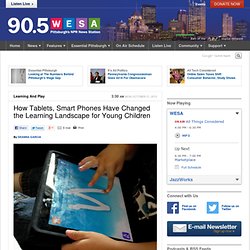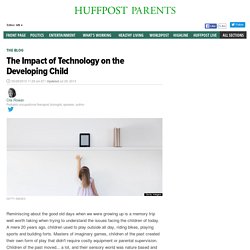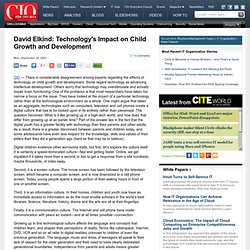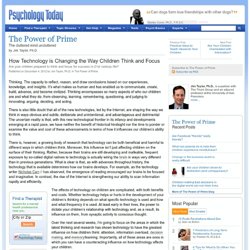

Earlychildhood NEWS - Article Reading Center. We are always looking for the magic bullet, something that will solve all our problems.

And, today this magic bullet for education is technology. It will solve all our problems! It will increase academic skills, reduce dropout rates, eliminate the racial divide in academic performance, and increase SAT scores. And it will make the lives of teachers easier. Well, it may not accomplish all of these goals, but educational technology does have a place in early childhood. Are Computers Developmentally Appropriate? To evaluate whether computers are developmentally appropriate for children over age three, we need to determine the developmental needs of these children.
Howard Gardner has shown that young children exhibit a diversity of learning styles, and that the optimum way for many children to learn is not the traditional teacher-directed, verbal approach (, 1987). 1. Using Technology in the Early Childhood Classroom. By Kimberly Moore Kneas, Ph.D. and Bruce D.

Perry, M.D., Ph.D. Early Childhood Today: Are young children's brains (ages three through six) well suited to the use of technology? (We define technology as children using cameras, computers, tape recorders and video cameras in classroom projects.) If so, how? Are some forms of technology better than others for these specific age levels? Dr. I see technology doing the same things today. Modern technologies are very powerful because they rely on one of the most powerful genetic biases we do have — the preference for visually presented information.
Viewcontent. How Tablets, Smart Phones Have Changed the Learning Landscape for Young Children. Bill Cosby once said “the essence of childhood, of course, is play.”

But play for children today is sometimes very different than it was even five or 10 years ago, as the prevalence of smart phones and tablets is changing the way children play and learn. Take 4-year-old Max. He’s in preschool and is learning to read and spell, sometimes with the help of apps on his mom and dad’s iPhone or iPad. “He’s only four, but I see him pointing out letters in print, like on signs or in newspapers or books that are laying around,” said Dawn Ferdinand, Max’s mom. “I think the fact that he’s tracing in these letters as he’s playing these games is helping him to identify them out in the real world and that’s really exciting to see.”
Technology’s Continued Role Technology isn’t going anywhere, and if anything, it will continue to become more pervasive as even preschools begin to use iPads and other new technologies. That differentiation between passive and interactive is key, according to experts. Cris Rowan: The Impact of Technology on the Developing Child.
Reminiscing about the good old days when we were growing up is a memory trip well worth taking when trying to understand the issues facing the children of today.

A mere 20 years ago, children used to play outside all day, riding bikes, playing sports and building forts. Masters of imaginary games, children of the past created their own form of play that didn't require costly equipment or parental supervision. Children of the past moved... a lot, and their sensory world was nature based and simple. In the past, family time was often spent doing chores, and children had expectations to meet on a daily basis. The dining room table was a central place where families came together to eat and talk about their day, and after dinner became the center for baking, crafts and homework. Today's families are different. Reviewing The Impact Of Technology On Child Development And Behavior. David Elkind: Technology's Impact on Child Growth and Development.
CIO — There is considerable disagreement among experts regarding the effects of technology on child growth and development.

Some regard technology as advancing intellectual development. Others worry that technology may overstimulate and actually impair brain functioning. One of the problems is that most researchers have taken too narrow a focus on the issue. They have looked at the impact of a particular technology rather than at the technological environment as a whole. One might argue that taken as an aggregate, technologies such as computers, television and cell phones create a digital culture that has to be looked upon in its entirety rather than piecemeal. Digital children evidence other worrisome traits, but first, let’s explore the culture itself. Second, it is a screen culture. Third, it is an information culture. Top 12 Ways Technology Changed Learning. In the 21st century, technology has changed the ways in which we communicate and go about our lives.

Very few educators would disagree with the notion that technology has dramatically changed the teaching and learning process. With the help of some fellow teachers, here is a short list of the top 12 ways how technology has changed education: Communication Evolution Because we text, our students have learned a dialect that we don't always understand. Kids communicate in many different modalities as a result of technology. Expanding Audience Students' sense of audience is completely different. Effective teachers are always on the prowl for new and exciting teaching... As December rolls by, the holiday hype has most likely invaded your classroom.... Restorative justice has been helping educators entirely rethink the way they... Teachers should try out some of the following 21st-century technology in the...
Here are a few signs that will ensure that you, through your teaching... Wesa. How Technology is Changing the Way Children Think and Focus. Thinking.
